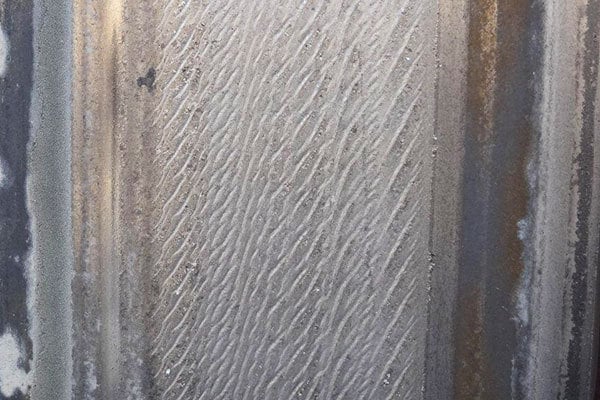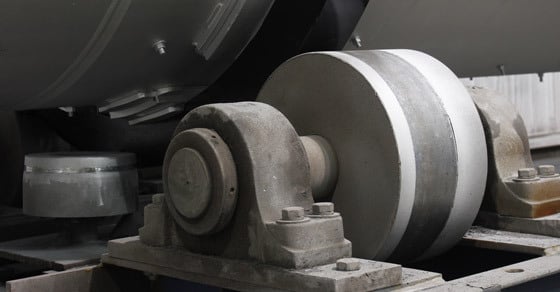Trunnion rollers, or trunnion wheels, are a crucial component in the foundation of any rotary drum, providing support to the unit and helping to facilitate smooth rotation.
Ensuring trunnion rollers are properly maintained is essential to avoiding unnecessary downtime and maintenance costs. Knowing where issues can occur, as well as what to look for and how to resolve problems is critical to prolonging the life of the equipment. For these reasons, properly trained operators and maintenance personnel, as well as a partnership with a qualified rotary drum service provider, should be at the center of any preventative maintenance program.
What follows is an overview of some of the most commonly experienced trunnion roller issues.
Common Trunnion Roller Issues
Quality trunnion roller assemblies are generally reliable and low maintenance. However, depending on the specific operating conditions, they can experience issues from time to time. The most common issues operators run into are summarized here.
Wear or Damage to Face of Trunnion
By far the most common issue rotary drum operators run into with trunnion rollers is a worn or damaged face. When the face of a trunnion wheel becomes worn or sustains damage, though superficial, the change in base conditions exacerbates any existing misalignment of the drum and promotes added stress on all components.
Causes of Trunnion Roller Wear
There are a number of potential causes of trunnion roller wear, but the most common is rotary drum misalignment, a condition in which the structural balance of the drum becomes compromised, either due to regular wear, or an issue with the drum or one of its components.
Other common culprits in trunnion roller wear include fugitive material or foreign objects allowed to get in the pinch point between the tire and trunnion, improper or inadequate lubrication, and excessive wheel skewing.
How to Identify Wear
Trunnion roller wear can be identified through a simple visual inspection. Trunnions, along with other drum components, should be regularly inspected as part of a preventative maintenance program. Any wear or damage, such as cracks, pitting, spalling, timing marks or otherwise, should be addressed as soon as possible.

Close-up view of a wear pattern known as “pitting” on a trunnion roller
How to Resolve Trunnion Roller Wear
Plant managers have two options in resolving wear:
- Trunnion Roller Grinding: Grinding is a resurfacing/reconditioning technique in which the worn surface is ground down by a special tool, revealing a like-new surface.
- Trunnion Roller Replacement: When wear is too severe for grinding, or when the trunnion roller has already been ground too many times, compromising the diameter of the roller, replacement is necessary.
In both cases, rotary drum alignment will be required upon completion of grinding, as base conditions have changed and the drum must be realigned.

Trunnion roller grinding in progress
Inadequate Diameter
Another common issue experienced with trunnion rollers is an inadequate diameter. When this occurs, the drum becomes misaligned, and the slope of the drum changes. This then alters the retention time, which can result in off-spec product.
Causes of Inadequate Trunnion Roller Diameter
While grinding typically removes only a small fraction of the trunnion diameter, excessive grinding, or numerous grinds over a period of years eventually decreases the diameter of the trunnion to a point where it no longer allows the drum to sit at the intended slope.
It’s important to note that the need for regular grinding is indicative of an underlying issue with the drum; a mechanically stable drum should not produce wear on tires and trunnions.
How to Identify an Inadequate Trunnion Roller Diameter
A good rotary drum service provider should recognize and alert to inferior trunnion diameter during maintenance procedures such as grinding, alignment, or even an equipment audit or annual inspection.
However, not all service providers look beyond the assigned task. For this reason, rotary drum operators should also be trained to recognize the signs of a roller that has worn beyond the acceptable level. Potential signs include an unexplained change in retention time (as well as product characteristics), a high thrust load on bearings, and hot bearings (due to an increased thrust load).
How to Resolve an Inadequate Diameter
The only option available when a trunnion roller becomes too small, is replacement. FEECO recommends a trunnion roller be replaced when it has lost 10% of its original diameter, in order to avoid affecting other drum components or process parameters.

Replacement trunnion rollers awaiting shipment
Excessive Skewing
Skewing of the trunnion roller bearings is carried out to maintain proper rotary drum float, or the position in which the drum sits between thrust rollers, which prevent the drum from drifting along its longitudinal axis.
If bearings have been over-skewed for an extended period of time, additional damage can result and may require repair; leaving a drum in this condition causes accelerated wear on tires and trunnions that could eventually prevent the drum from rotating.
Causes of Excessive Skewing
Excessive skewing is a common problem because it is easily done by accident. Since skewing adjustments can take up to a full day to show their full effect, operators and maintenance personnel may inadvertently over-skew the bearings because they don’t immediately see the full effects of the adjustment.
How to Identify Excessive Skewing of Trunnion Rollers
A drum riding too hard in one direction (i.e., uphill or downhill) may indicate excessive skewing. Another potential sign of excessive skewing is a hot bearing. Additionally, wear or damage on tires and/or trunnions may also indicate that the bearings have been over-skewed.

Trunnion roller wear resulting from excessive skewing
How to Resolve Excessive Skewing
Since excessive skewing is simply an over-adjustment of the trunnion bearings, it can be resolved by modifying the adjustment until the drum reaches proper float and the trunnions are no longer overly skewed.
Skewing of bearings must be carefully conducted, as over-skewing, under-skewing, or skewing bearings in the wrong direction can cause extensive damage. For this reason, FEECO recommends double and even triple checking bearing movement prior to making any actual adjustments.
The need for excessive skewing may also indicate a problem with trunnion installation or the rotary drum’s base.
Rotary Drum Inspections & Repair
One of the challenges in troubleshooting a rotary drum is that issues can have varying or even interrelated causes that are not always obvious. Further, making the wrong adjustments in an attempt to resolve an issue can be a costly mistake. This is why training rotary drum operators and maintenance personnel and partnering with a trusted service provider are so critical. Plant managers should opt for an annual rotary drum inspection by a qualified service provider at the very minimum. This will help to catch problems at their onset, before they have a chance to escalate.
Plant managers in charge of multiple drums can also benefit from monthly dynamic inspections, which takes a systematic approach to monitoring multi-drum facilities; each month a different drum is shut down and thoroughly inspected, while the other drums remain in operation and are visually inspected.
Conclusion
Trunnion rollers are essential to rotary drum operation. By keeping them properly maintained and immediately addressing any issues that arise, plant managers can protect against unnecessary downtime and maintenance costs, while protecting plant assets.
Our long history in providing the industry’s most reputable rotary drums and service support has made the FEECO Customer Service Team a favored service provider in nearly every industry, whether the equipment was built by FEECO or by a competitor. In addition to inspections and audits, we offer a range of rotary drum services and spare parts to keep your equipment running its best. For more information on how our Customer Service Team can help you, contact us today!



